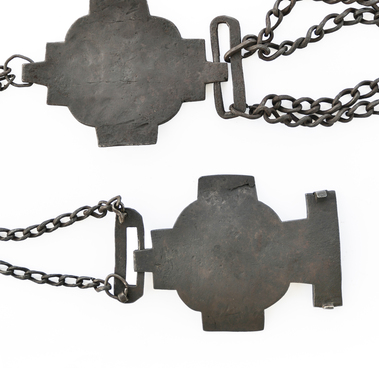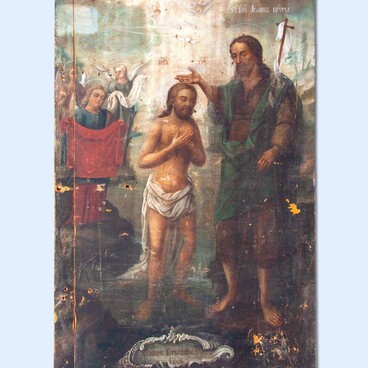The altar hand blessing cross is a mandatory attribute of every Orthodox Church. It is placed in the altar, on a small rectangular table, which is called the communion table. The Gospel, the antimins (a quadrangular large piece of linen cloth containing relics), and the ciborium for the Communion prosphora and wine are placed on the table. In Orthodox Christian tradition, the communion table is considered the place where Christ is invisibly present during service. The altar hand blessing cross is used by priests to bless the congregation, consecrate water, and is used in Cross Procession. Parishioners also kiss it after prayer.
The altar hand blessing cross from the collection of the Tobolsk Museum is made of copper. In Siberia, this metal was one of the most popular materials for church items, folding icons, and pectoral crosses. People extracted copper in large quantities; it was easy to process and relatively cheap.
The cross has eight points: in addition to the main crossbar, there are two more at the top and bottom. Around the perimeter, it is fringed with a thin rim. Almost the entire surface is decorated with a relief pattern. At the top of the cross, there is a figure of Sabaoth, or God the Father. Underneath, one can see angels flying with scarves in their hands, and between them, there is a dove, which represents the Holy Spirit.
In the central part of the cross, there is a relief figure of the crucified Jesus. His head is crowned with a patterned halo and a cross inside of it. Near the Savior’s palms, there is a picture of the moon and the sun, and at his feet is a human skull or Adam’s head. Legend has it that the first man on earth was buried on Calvary. Christ’s blood was shed on Adam’s remains during crucifixion and thus it symbolically cleansed the entire human race of its sins.
On the lower slanting crossbar, the master depicted a view of Jerusalem. The outline of the Calvary cross and the text of the canon to the Life-Giving Cross are embossed on the back of the piece,
The altar hand blessing cross from the collection of the Tobolsk Museum is made of copper. In Siberia, this metal was one of the most popular materials for church items, folding icons, and pectoral crosses. People extracted copper in large quantities; it was easy to process and relatively cheap.
The cross has eight points: in addition to the main crossbar, there are two more at the top and bottom. Around the perimeter, it is fringed with a thin rim. Almost the entire surface is decorated with a relief pattern. At the top of the cross, there is a figure of Sabaoth, or God the Father. Underneath, one can see angels flying with scarves in their hands, and between them, there is a dove, which represents the Holy Spirit.
In the central part of the cross, there is a relief figure of the crucified Jesus. His head is crowned with a patterned halo and a cross inside of it. Near the Savior’s palms, there is a picture of the moon and the sun, and at his feet is a human skull or Adam’s head. Legend has it that the first man on earth was buried on Calvary. Christ’s blood was shed on Adam’s remains during crucifixion and thus it symbolically cleansed the entire human race of its sins.
On the lower slanting crossbar, the master depicted a view of Jerusalem. The outline of the Calvary cross and the text of the canon to the Life-Giving Cross are embossed on the back of the piece,



